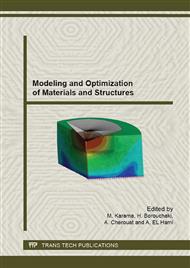p.41
p.44
p.52
p.61
p.71
p.80
p.87
p.94
p.102
A New Parameter Identification Approach by Experimental Design and Multiple Regressions Method: Application to the Elastoplastic Damage Constitutive Law of a Steel Thin Parts
Abstract:
In this paper, a new procedure for the identification of constitutive elastoplastic models coupled with an isotropic damage variable under large strains is presented. It is a statistical approach used for experimental characterization and identification based on a design of experiments of numerical simulations of mechanical characterization tests. The parameters for a reference material are determined by multiple linear regression as a function of shape indices.The material of reference is mild steel E24; it was characterized in a series of tensile tests of thin plate specimens. The Swift hardening law coupled with an isotropic damage variable that was identified by introducing in the established formulations shape indexes extracted from the experimental tension/elongation curves.The number of simulations required for the identification of the parameters of the reference material is roughly 18% of the number required by the inverse method (simplex).
Info:
Periodical:
Pages:
71-79
Citation:
Online since:
April 2015
Authors:
Price:
Сopyright:
© 2015 Trans Tech Publications Ltd. All Rights Reserved
Share:
Citation:


